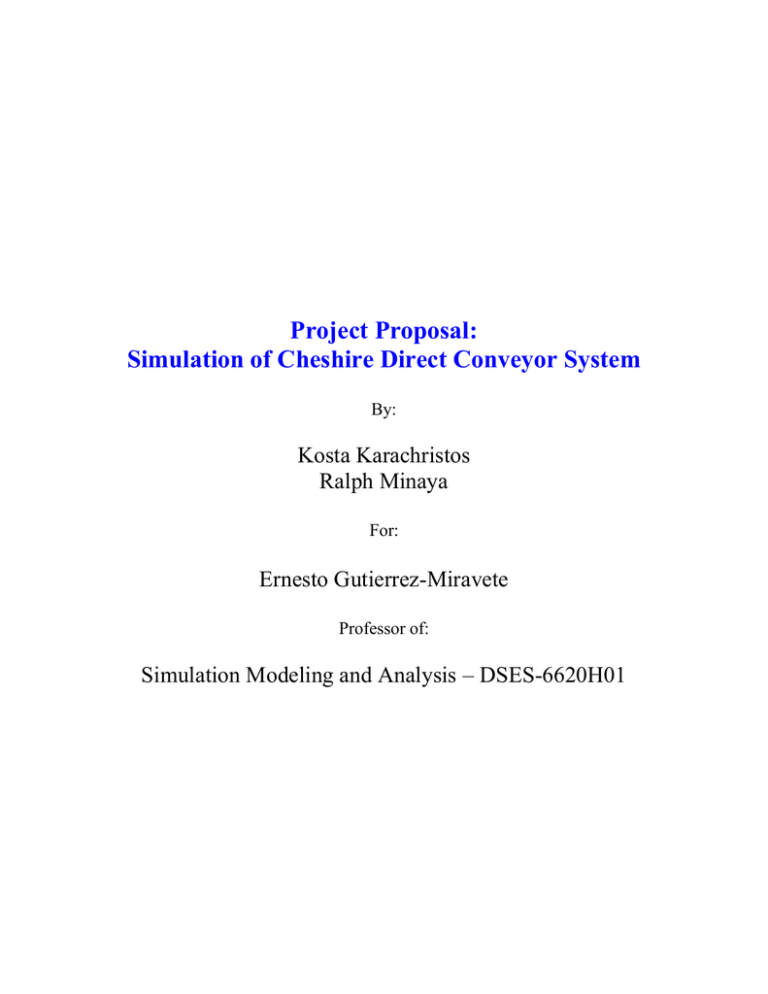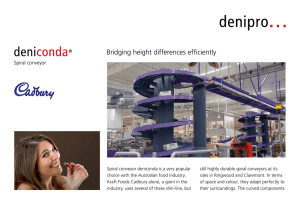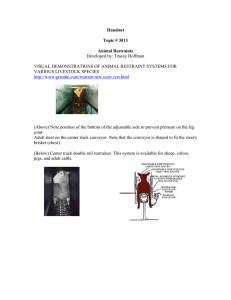Project Proposal: Simulation of Cheshire Direct Conveyor System
advertisement

Project Proposal: Simulation of Cheshire Direct Conveyor System By: Kosta Karachristos Ralph Minaya For: Ernesto Gutierrez-Miravete Professor of: Simulation Modeling and Analysis – DSES-6620H01 ACKNOWLEDGEMENTS We would like to give special thanks to the Cheshire Direct Management Team for their involvement in our project for Course DSES-6906 Simulation & Modeling Analysis at Rensselaer Hartford. 2 TABLE OF CONTENTS Abstract 4 1.0 Introduction 4 2.0 Objective 5 3.0 Background 5 4.0 Scope 6 4.1 Receiving 6 4.2 Automatic Conveyor 6 4.3 Stock Put-away 7 5.0 Requirements 7 5.1 Receiving 7 5.2 Automatic Conveyor 7 5.3 Stock Put-away 8 6.0 Data Collection 8 6.1 Receiving 8 6.2 Automatic Conveyor 8 6.3 Stock Put-away 9 7.0 Model Definition 9 8.0 Current and Proposed System Behavior 11 8.1 Current System Results 11 8.2 Proposed System Results 11 9.0 Model Validation and Verification 12 10.0 Conclusion and Recommendations 13 11.0 References 13 Appendix A: Flow Diagram of System 14 Appendix B: Pictures of System Components 16 Appendix C: Data Collection Tables 20 Receiving, Conveyor, & Stock Put Away Appendix D: Fitted Distributions 23 Receiving & Stock Put-away Appendix E: Current and Proposed Models Output 28 3 ABSTRACT This report determined the daily schedule between the receiving work centers and the put-away work centers to minimize bottlenecks on the automatic conveyor at Cheshire Direct. With observations of the system, it was concluded that imbalances between the rate bin boxes were loaded vs. the time required to unload the bin boxes caused bottlenecks. Defining the speed and loading/unloading rates of work centers assisted in simulating the existing conveyor system. With the assistance of the simulation software, it was evident that the rate that receiving inputs merchandise far exceeded the rate that the put away personnel can stock into location. The existing system loads merchandise onto the conveyor at a rate of 0.55 boxes/min, creating bottlenecks that would leave 200 bin boxes still on the conveyor after an 8hr shift. Receiving should load 0.7 boxes/min in order for the automatic conveyor system to run without major bottlenecks. Running at 0.7 boxes/min enables the conveyor to run with constant flow and minimal bottlenecks of only leaving 5 bin boxes in system after an 8hr shift. 1.0 INTRODUCTION Cheshire Direct is a distribution center that supports catalog operations for Bloomingdale’s by Mail (BBM), Macy’s By Mail (MBM), and Macys.com. These catalogs and web sites offer products in home-furnishings, men’s and women’s designer clothing, jewelry, lingerie, cosmetics and fragrances. Consumers can place orders by phone, mail in forms, or electronically through the web site. Once customers place their orders, they must be packed and shipped within 24hrs, creating a tremendous demand on the work centers. The centers consist of receiving, 4 automatic conveyors, and stock put-away areas. In the receiving area, merchandise is processed in two different locations, and released to the subsequent work center. Items move from one work center to the next through the automated conveyor system, which diverts the products to the proper stock area via barcode scanners. In the put-away area goods are stored in the appropriate shelving locations. Adhering to an hourly schedule at the receiving end, all processed merchandise is presented to the automated conveyor regardless of its existing utilization. Despite the current conveyor capacity, the product is released, causing bottlenecks when the system is busy. As a result, many man-hours are spent clearing bottlenecks in the system. 2.0 OBJECTIVE The goal was to coordinate the workload between the receiving and stock putaway work centers, based on system capacity, to minimize bottlenecks in the downstream process. 3.0 BACKGROUND This section describes the process flow before merchandise can be shipped to customers. The process consists of receiving, automatic conveyors, and stock put-away areas. See Appendix A for a simplified schematic of the real world system applied to our project. Also, Appendix B shows pictures of each process area. 3.1 Receiving This aspect of the process allots to the receiving of merchandise from various product manufacturers. Merchandise is prepared for put-away in the receiving prep mezzanine, and at the pallet receiving areas. Receiving packs the merchandise into bin boxes, which are labeled with bar codes and proper storage location information. 3.2 Automatic Conveyors 5 Once the boxes are on the conveyor system, the barcode system directs them to the put-away location. 3.3 Stock Put-away Stock put-away personnel (3 persons) remove boxes from the conveyor and transport them to the proper storage locations. 4.0 SCOPE Our methodology will consist of modeling the existing conveyor system with specific assumptions, and based on the results, adjustments will be made to achieve the desired results. Assumptions, necessary data, and performance metrics are described in the sections following: 4.1 Receiving Assumptions: Merchandise is readily available, no transport time required to conveyor There is no box in the system initially No operators are included in this activity Receiving prep mezzanine, and pallet receiving areas considered as one processing area Boxes are pulled via FIFO Never experience failure Data Collection: Arrival time based on existing production data -Boxes/Min 4.2 Conveyor Assumptions: Conveyor will serve as input queue Entities (boxes) will move at constant rate (ft/min), & no distance between each other Never mechanical experiences failures, except bottlenecks Data Collection: Conveyor speed (ft/min) – defines entity speed Conveyor length (ft) – defines queue length Conveyor capacity – defines max number of boxes that fit into queue length Performance Metrics: Bottlenecks/Day – when entity number in conveyor is > than conveyor capacity Conveyor downtime – waiting time in queue/conveyor 6 4.3 Stock Put-away Assumptions: Server is initially idle 3 persons considered as resources Storage location is readily available, no walking distance for resource Data Collection: Put-away rate -Boxes/Min Performance Metrics: Daily % Utilization 5.0 REQUIREMENTS Putting this work together required understanding the system through the different components, that is Receiving, the Conveyor system, and Stock. A general overview of the system was provided by the manager of Stock and Industrial Engineering, the supervisor of the Receiving Department at the first visit. 5.1 Receiving Different visits were made to the different departments so we could learn the processes. In Receiving we observed the way the bin boxes were inducted in the conveyor system. We also observed the speed the bin boxes were coming to the conveyor. The most difficult part of this project in receiving was the data collection process. All the input data for the model was gathered from the daily production report, which took a considerable amount of time. 5.2 Automated Conveyor System The behavior of the conveyor system was analyzed. Being a fifteen year old conveyor, the flow is not only affected because of the way the bin boxes are being currently released from Receiving, but also from failures due to mechanical malfunctions. We had to measure physically the conveyor because no blue print was available at the moment. The same thing was done with the conveyor speed. Samples of bin boxes had 7 to be tracked in the system to determine the average speed of the system. We had to watch the conveyor system working for more than eight hours during morning and afternoon hours. We also noticed that releases were more frequent during afternoon hours. 5.3 Stock Several employees in Stock were interviewed along with supervisory personnel to identify what were the real causes of the bottlenecks. None of the staff knew accurately how many hours they put on clearing the bottlenecks on a daily basis, but we knew that the amount of time they were spending on that was more than two hours per shift. Once again, the input data for the model was gathered from daily production reports. Once the current model was validated and verified, it was run. The results were discussed with the Manager of Stock to check if the model was reflecting the reality of the system. 6.0 DATA COLLECTION This section describes how the data collected for receiving, automatic conveyors, and stock-put away areas was utilized to determine the loading rates of receiving, and unloading rates of stock-put away areas. Also, the conveyor parameters were calculated. The data collection can be seen in Appendix C for receiving, conveyors, and put-away. 6.1 Receiving Receiving data was gathered form production records generated in the receiving Detailed and Pallet work centers. Daily volumes were converted into bin per minutes. The number of weeks considered was 18 weeks. 6.2 Automatic Conveyor The list below summarizes the conveyor parameters calculated: Conveyor Length = 714 ft Conveyor Speed = 122 ft/min 8 Conveyor Capacity = 327 boxes The overall length of the system was derived from manually measuring the conveyor used between the receiving and stock put-away centers. The conveyor speed was calculated from a time study conducted at different sections of the conveyor system. Ten boxes were timed for each section of the conveyor and an average time was calculated. The table in Appendix C lists the length of the different sections and the average time it took to travel along that distance and the overall average time for a box to travel through the system = 122 ft/min. 6.3 Stock Put-away Put away data was gathered from the warehouse management system reports (Base Plus 105) for 18 weeks. Total weekly volumes consisted of three different items, 1) Active cartons, 2) Reserve cartons, and 3) Truck put away cartons. Volumes were then added to get the total put away volumes handled by the 3 employees. The total put away weekly hours for these respective volumes was calculated from recorded data. Weekly volumes and their corresponding put away hours appear in Appendix C. The average put away time per bin box = 1.02 minutes. 7.0 MODEL DEFINITION The bin boxes arrive at the receiving end and then they are loaded onto the conveyor. The conveyor transports them down to the scanner, and then they are diverted to the putaway area. A detailed description of the model components follows. Locations The model was built taking in consideration the locations below: 9 Automatic Conveyor System The conveyor has a total length of 714 feet, and a width of 2.87 feet. The conveyor capacity is infinite, and runs at a constant speed of 122 fpm. It does not experience any down time. The rules that govern the conveyor system is FIFO (first bin box to enter onto the conveyor will be the first to be put away). Putaway Personnel There are 3 putaway persons who take the bin boxes off the conveyor and store them. These persons are Putaway_Persons, Putaway_Persons2, and Putway_Persons3. They putaway bin boxes as they come down the conveyor following the oldest bin box. The putaway rate is 1 bin box per minute. There is not downtime associated with any of the putaway persons, and they can handle one bin box at a time. Entity The entity used in the model is the bin box. The bin box is 2.00 wide by 2.17 long. It moves through the conveyor system at a speed of 122 fpm. There is not distance between the bin boxes moving through the conveyor system. Processing Bin boxes arrive at an initial constant rate of 0.55 bin per minute. They move through the conveyor system at a constant speed of 122 fpm, and then they are putaway to the specific locations at a rate of 1 bin box per minute following a Weibull distribution. Arrivals Bin boxes arrive to the conveyor system following a normal distribution that varied from 0.55 to 1.0 bin boxes per minute and standard deviation of 20% in every case. 10 8.0 CURRENT AND PROPOSED SYSTEM BEHAVIORS Once the distributions were determined for each area, the current modeled system was simulated for verification and determining bottlenecks/loses in the system. Through much iteration, we discovered the correct arrival rate for bin boxes to be introduced into the system. For the system altering the conveyor speed and the number of personnel in the put away area could not be considered. This was so because the real system conveyor has many convergence’s and we do not want to hire or eliminate a job at the facility. 8.1 Current System The fitted distribution for the production data recorded was the Weibull distribution. The average utilization for the 3 resources was around 98 %, with 871 total entries into the system. The average minutes of a bin box in the system were 56.36 minutes. A total of 197 bin boxes remained in the system for the amount of time the simulation was ran. These results can be seen on Appendix E. 8.2 Proposed System Different experiments were run to come up with the proposed systems. We considered an average daily production of 11,000 units and assumed a normal distribution for the bin box arrivals. We altered the arrival rate of the existing model from .55 to 1 min per bin box and assumed a 20% variation. Table 1 shows the iterations of the proposed model versus the existing model. The % Utilization of each put away person, and bins left over on the conveyor system were the driving factors to determine the appropriate arrival rate. Comparing the utilization and bins left over for the different runs the optimum Model was the one with a mean of 0 .7 bins per minute and standard deviation of 0.14. This distribution allows 686 bin boxes to be processed, and a utilization of 98.11% of the three 11 Table 1: Current & Proposed Results Model Current (6 replications) Proposed (6 replications) Current and Proposed Results Average Distribution Total Entries Minutes Weibull (24.2, 0.563) 871 56.48 N (0.55, 0.11) 874 57.31 N (0.60, 0.12) 799 40.23 N (0.70, 0.14) 686 8.05 N (0.80, 0.16) 597 5.82 N (0.90, 0.18) 536 5.79 N (1.0, 0.20) 480 5.79 Left Over Bins 197 199 125 15 7 7 6 Person 1 98.67 98.69 98.66 98.27 86.82 80.69 78.63 Utilization Person 2 Person 3 98.55 98.43 98.57 98.47 98.53 98.41 98.12 97.98 86.16 85.56 78.19 73.41 73.97 55.45 put away persons, with only 15 boxes left over on conveyor, therefore bin boxes minimized. See Appendix E for details of iteration outputs. 9.0 MODEL VERIFICATION & VALIDATION The simulation model correctly reflected the conceptual model. The conveyor is an accumulation conveyor with previously stated length and speed. Since the conveyor is a location, the routing of the bin box (the entity) was assigned to the conveyor from receiving and from the conveyor to the put away area. The time in queue was defined as the time a bin box takes to get from the beginning of the conveyor to the put away area. Since the length of the bin box is 2 ft long and the speed of the conveyor is 122 ft/min, the average time for the box to travel the length of the conveyor is 5.5 min. Studying the time it takes boxes to get to the stock put away area was about 55 min on the existing system. This value is very close to the existing model distribution (56.48min) for average minutes in queue as seen on Appendix E. Furthermore, the put away rate of each person is 1 bin box/min, and assuming a normal distribution of 1 min should give us an average time in queue of 5 min and small number of bins left over. The simulation was run with the assumed normal distribution and the average time in queue from the existing model output was 5.79min. 12 Therefore checking with actual studied activities of the conveyor and comparing them to the model out put we were confident to conclude that the model correctly describes the conveyor system at Cheshire Direct. 10.0 CONCLUSIONS & RECOMENDATIONS When we gradually increased the amount of bin boxes sent from the Receiving area to the conveyor system from 0.55 to 0.7 bin boxes per minute the Stock’s putaway personnel utilization went up to 98%, and the amount of bin boxes that remained on the conveyor went down to 17 units. Bringing the arrival rate closer to the putaway rate based on the system capacity minimizes conveyor bottlenecks and increases putaway utilization. Below are listed the recommendations for the proposed system based on the observations from 10 replications of the new model. 1. Bin boxes must be released at a rate of 0.7 units per minute from the receiving end following a pre-set daily schedule. 2. Receiving personnel must communicate with Stock personnel before every release to make sure they are available for putaway. 3. Arrangements must be made with stock in the event the arrival rate should increase due to production volumes in receiving. Different bin box releases from the Receiving Area must be done at a rate close to the putaway rate in then Stock Putaway Area, 1.0 bin per minute, so the flow through the conveyor system be smooth. 11.0 REFRENCES 1. C. R Harrel, Ghosh & R. Bowden. Simulation Using ProModel, 3rd ed. McGraw Hill, Boston, 2000. 2. A.M. Law & W.D. Kelton. Simulation Modeling and Analyiss, 3rd ed. McGraw Hill, New York, 2000. 13 APPENDIX A: FLOW DIAGRAM OF SYSTEM 14 Appendix A: Flow Diagram Of System Receiving Area Bin Boxes CONVEYOR SYSTEM Storage Locations Put-Away 15 APPENDIX B: PICTURES OF SYSTEM COMPONENT 16 APPENDIX B: Receiving PREP AREA CONVEYOR 17 APPENDIX B: Automatic Conveyor Conveyor Bin Box Bar Scanner 18 APPENDIX B: Stock Put Away Stock Locations Bin Box 19 APPENDIX C: DATA COLLECTION TABLES 20 APPENDIX C: DATA COLLECTION TABLES RECEIVING AREA PALLET & DETAIL DATE 8/28 8/29 8/30 8/31 9/1 9/5 9/6 9/7 9/8 9/11 9/12 9/13 9/14 9/15 9/18 9/19 PALLET 0 0 0 0 1016 643 0 0 382 726 499 214 1198 188 437 742 DETAIL 382 1049 1053 1207 449 857 449 768 816 538 568 1387 0 0 0 0 BIN SUM 382 1049 1053 1207 1465 1500 449 768 1198 1264 1067 1601 1198 188 437 742 Units/Min 3056 8392 8424 9656 11721 11998 3592 6144 9581 10109 8538 12805 9587 1502 3494 5932 Min 5659 14986 12573 18569 22115 20336 6414 11592 19162 17735 14721 23282 17120 2590 6239 10785 Bins/Min 0.54 0.56 0.67 0.52 0.53 0.59 0.56 0.53 0.5 0.57 0.58 0.55 0.56 0.58 0.56 0.55 DATE 9/20 9/22 9/25 9/26 9/27 9/28 9/29 10/2 10/3 10/4 10/5 10/9 10/10 10/11 10/12 10/16 PALLET 488 1031 934 790 166 693 905 41 1182 821 229 261 434 478 844 474 DETAIL 0 0 0 0 0 0 0 0 0 0 0 0 0 0 0 0 BIN SUM 488 1031 934 790 166 693 905 41 1182 821 229 261 434 478 844 474 Units/Min 3904 8251 7474 6321 1329 5540 7237 325 9458 6565 1829 2088 3470 3822 6751 3789 Min 7508 14226 13346 11493 2556 9552 14474 625 16307 11936 3153 3600 6088 7644 12502 7149 Bins/Min 0.52 0.58 0.56 0.55 0.52 0.58 0.5 0.52 0.58 0.55 0.58 0.58 0.57 0.5 0.54 0.53 10/18 10/19 10/20 10/24 10/25 10/26 10/27 10/30 10/31 11/3 11/6 11/7 11/8 11/9 11/10 11/13 PALLET 456 392 291 473 321 349 544 157 483 1188 558 543 580 1249 645 527 DETAIL 0 0 0 0 0 0 0 0 0 0 0 0 0 0 0 0 DATE BIN SUM 456 392 291 473 321 349 544 157 483 1188 558 543 580 1249 645 527 Units/Min 3649 3133 2331 3786 2566 2793 4355 1252 3865 9500 4462 4347 4642 9989 5160 4217 Min 6635 6266 3951 6884 4349 4900 8375 2159 7027 16379 7828 8694 8596 18847 9382 8434 Bins/Min 0.55 0.5 0.59 0.55 0.59 0.57 0.52 0.58 0.55 0.58 0.57 0.5 0.54 0.53 0.55 0.5 Average Bin/min: 0.56 Appendix C (Cont.) CONVEYOR SPEED CALCULATION Length (ft) Time (min) Speed (ft/min) 357 3.18 112 244 2.04 119 357 2.97 120 714 5.26 135 122 Total Average PUTAWAY DATA COLLECTION TABLE 6/03 6/10 7/1 7/8 7/15 7/22 7/29 8/5/00 8/12 8/19 8/26 9/2 9/9 9/16 9/30 Flat Active Cartons 978 1038 1832 913 2523 1867 1977 951 1813 2261 1295 1509 1839 1512 3495 Reserve Carton 728 829 1096 622 1642 1417 1854 796 1574 2030 1342 1028 1188 827 1283 Truck B Carton 1011 1421 664 414 1675 681 1330 974 1040 1091 1618 1813 892 1123 3144 HRS/WK 44.44 53.62 59.31 32.14 95.94 65.52 84.91 44.54 72.92 88.79 69.57 70.99 64.57 56.76 129.41 Total Packed 2717 3288 3592 1949 5840 3965 5161 2721 4427 5382 4255 4350 3919 3462 7922 Bins/Min 1.02 1.02 1.01 1.01 1.01 1.01 1.01 1.02 1.01 1.01 1.02 1.02 1.01 1.02 1.02 2 3 APPENDIX D: FITTED DISTRIBUTIONS APPENDIX E: CURRENT & PROPOSED MODEL OUTPUTS 2


